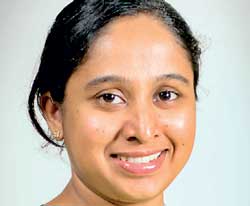Monday Mar 10, 2025
Monday Mar 10, 2025
Tuesday, 27 September 2016 16:41 - - {{hitsCtrl.values.hits}}
By Kanchana Wickramasinghe
Sri Lanka is witnessing a rise in tourism since the end of the war. An important aspect that needs consideration in the country’s post-war tourism development is making tourism accessible for all, which is also the theme of this year’s World Tourism Day (27 September).
This year, the day aims to generate awareness on ‘Promoting Universal Accessibility’. Awareness is being created to give special attention to the needs of disabled (permanent or temporary), families with small children, ageing population, etc. The ‘Tourism for All’ concept includes aspects of accessibility, sustainability, and equitable participation by all.
There are positive examples from around the world on attempts to make tourism more accessible in their respective destinations. For instance, in India selected heritage sites were made easily reachable for both domestic and foreign tourists to visitors with visual and other impairments. Interestingly, it was successful in striking a balance between strict conservation attempts and tourism, which is accessible. There are many other examples from Japan, Canada, Spain, etc., on various initiatives on accessible tourism.
An opportunity
As World Tourism Organization (UNWTO) highlights, accessible tourism can bring in customer satisfaction and increased competitiveness to the destination. This is a well proved fact according to available good practices. Thus making tourism more accessible should be considered an opportunity that can deliver positive benefits.
The World Population Aging 2015 report of the UN says that by 2030, older persons (aged 60 years or more) ratio to persons with other age categories will be 1:6. This will have clear implications on the tourism industry. Older tourists have stable incomes with more leisure time when compared to other age categories. Also as UNWTO points out, they have more free time to travel anytime during the year.
In Sri Lanka, one can observe an increasing trend of old age tourists visiting the country, as per the data presented in the Annual Statistical Report 2015 of the Sri Lanka Tourism Development Authority (SLTDA). Over the past five years, the on average the percentage of old age people (60 years or more), who visited the country was around 11.4 of overall visitors. This can be used as a market opportunity by the industry by introducing appropriate strategies and facilities to address the specific needs of old age visitors.
Steps taken
The new hotel classification system, which came into place recently, has certain criteria addressing some aspects of making tourism inclusive for all. The hotel classification system has incorporated two aspects on facilities for guests with restricted ability and public toilets, as minimum requirements for each category of the hotels.
‘Compliance with the Design Standards of the Accessibility Regulations No. 1 of 2006’ is listed under facilities for guests with restricted ability. Under the availability of public toilets, it mentions “at least one toilet with facilities for differently able or wheel chair users shall be available”. In addition, under the non-mandatory requirements for any star categories of tourist hotels, “Wheel chairs and stretchers shall be available for use in case of an emergency”.
In addition, the National Policy on Disability for Sri Lanka of year 2003 highlights the need for having “accessible tourism” under its sectoral policies and strategies on “Access to the Built Environment and Accessible Tourism“. It aims at improving accessibility to all visitors (both local and foreign) who have a disability.
Apart from the need for including the necessary guidelines for new hotels, it mentions the need to: (a) incorporate accessibility guidelines during refurbishments and reconstructions, (b) making major tourist sites and attractions accessible according to accessibility guidelines, and (c) making available the information about accessible hotels and tourist sites to travel agencies (both local and international) and on the internet.
It is noteworthy that the tourism businesses including the hotel sector have considered accessibility aspects in offering their services in their web marketing. However, there is a lack of information regarding this in Sri Lanka as a tourist destination.
UNWTO highlights that all aspects related to accessibility should be reflected across the tourism value chain, which include destination management, information and advertising, urban and architectural environments, modes of transport and stations, accommodation, food service and conventions, cultural activities, and other tourism activities and events. Sri Lanka should understand the existing gaps in terms of accessible tourism and orient its strategies to discover the possible economic potentials of this emerging market.
[Kanchana Wickramasinghe is a Research Economist at the Institute of Policy Studies of Sri Lanka (IPS). To view the article online and comment, visit the IPS blog ‘Talking Economics’ – www.ips.lk/talkingeconomics.]
Discover Kapruka, the leading online shopping platform in Sri Lanka, where you can conveniently send Gifts and Flowers to your loved ones for any event including Valentine ’s Day. Explore a wide range of popular Shopping Categories on Kapruka, including Toys, Groceries, Electronics, Birthday Cakes, Fruits, Chocolates, Flower Bouquets, Clothing, Watches, Lingerie, Gift Sets and Jewellery. Also if you’re interested in selling with Kapruka, Partner Central by Kapruka is the best solution to start with. Moreover, through Kapruka Global Shop, you can also enjoy the convenience of purchasing products from renowned platforms like Amazon and eBay and have them delivered to Sri Lanka.
Discover Kapruka, the leading online shopping platform in Sri Lanka, where you can conveniently send Gifts and Flowers to your loved ones for any event including Valentine ’s Day. Explore a wide range of popular Shopping Categories on Kapruka, including Toys, Groceries, Electronics, Birthday Cakes, Fruits, Chocolates, Flower Bouquets, Clothing, Watches, Lingerie, Gift Sets and Jewellery. Also if you’re interested in selling with Kapruka, Partner Central by Kapruka is the best solution to start with. Moreover, through Kapruka Global Shop, you can also enjoy the convenience of purchasing products from renowned platforms like Amazon and eBay and have them delivered to Sri Lanka.